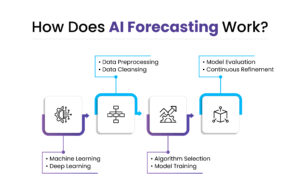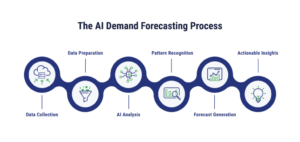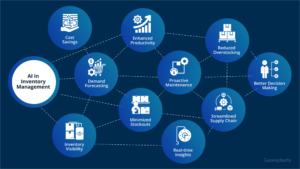In the fast-paced world of retail, inventory management is a constant tightrope walk. Overstocking leads to wasted space, deadstock, and lost profits. Understocking, on the other hand, results in stockouts, frustrated customers, and lost sales opportunities. Traditionally, demand forecasting has relied on historical sales data, gut instinct, and a dash of wishful thinking. But in today’s dynamic market, these methods simply don’t cut it. This is where Artificial Intelligence (AI) steps in, offering a powerful tool known as AI-powered demand forecasting.
What is AI Demand forecasting?
AI Demand Forecasting is the process of using artificial intelligence to predict future customer demand for products or services. It analyzes vast amounts of data from various sources to create more accurate and nuanced forecasts compared to traditional methods. Here’s a breakdown of the key aspects:
Leveraging AI: AI algorithms go beyond simple statistical analysis. They can identify complex patterns and relationships within data that might be missed by humans. This allows for a more comprehensive understanding of factors influencing demand.
Data sources: AI demand forecasting utilizes a wider range of data than just historical sales figures. This can include:
Why AI for demand forecasting?
AI can analyze vast amounts of data (both internal and external data) from various sources, including:
- Historical sales data
- Customer demographics
- Product information (seasonality, promotion)
- Market trends
- Weather patterns (for seasonal products)
- Social media sentiment
- Economic indicators
- Competitor activity
These complex datasets allow AI algorithms to identify hidden patterns and trends that traditional methods might miss. This allows for a more accurate and nuanced understanding of future demand.
How does AI-powered demand forecasting work?

There are several types of AI algorithms used for demand forecasting, each with its strengths and weaknesses. Here are a few common approaches:
- Time series analysis: This is a well-established technique that analyzes historical sales data to identify patterns, trends, and seasonality. By understanding these patterns, businesses can predict future demand fluctuations with a reasonable degree of accuracy.
- Neural networks: These are complex algorithms inspired by the human brain. Neural networks can analyze not just historical sales data, but also other relevant factors like marketing campaigns, competitor activity, and social media sentiment. By processing this vast amount of data, neural networks can uncover complex, non-linear patterns that might be missed by simpler methods. This often leads to more accurate and nuanced demand forecasts.
- Ensemble methods: This approach acknowledges that no single forecasting model is perfect. Ensemble methods combine predictions from multiple models, such as time series analysis and neural networks, to create a more robust and accurate forecast. By leveraging the strengths of different models and mitigating their individual weaknesses, ensemble methods can provide a more reliable picture of future demand.
6 categories of AI used in demand forecasting

- Machine Learning (ML): This is a foundational approach in AI. ML algorithms learn from historical data to identify patterns and trends. These patterns are then used to make predictions about future demand. Common ML algorithms used for forecasting include linear regression, decision trees, and random forests.
- Deep Learning (DL): A subfield of ML, Deep Learning uses artificial neural networks with multiple layers to process information. DL models can handle complex, non-linear relationships in data, leading to potentially more accurate forecasts compared to traditional ML techniques.
- Time series forecasting: This technique focuses specifically on analyzing historical data points over time. By identifying seasonal trends, cyclical patterns, and outliers, time series forecasting can predict future demand fluctuations. This is particularly useful for products with seasonal sales patterns.
- Statistical forecasting: This category utilizes statistical methods to analyze historical data and identify trends. Common statistical techniques include moving averages, exponential smoothing, and ARIMA (Autoregressive Integrated Moving Average) models. These methods provide a solid foundation for demand forecasting, but may not capture complex relationships in data as effectively as ML or DL approaches.
- Causal AI: This emerging field focuses on identifying the causal relationships between different factors and their impact on demand. By understanding the “why” behind demand fluctuations, businesses can make more informed decisions about influencing those factors. For example, causal AI might analyze the impact of marketing campaigns, competitor pricing strategies, or economic events on demand for specific products.
- Ensemble methods: This approach combines multiple forecasting models to leverage the strengths of each. By aggregating predictions from different models, ensemble methods can potentially improve the overall accuracy and robustness of the forecast. This is beneficial as individual models might have biases or limitations.
In addition to these categories, it’s important to consider:
- Hybrid models: Many forecasting solutions combine elements from different categories like machine learning and statistical methods for a more comprehensive approach.
External data integration: Advanced AI models can incorporate external data sources like weather patterns, social media sentiment, and economic indicators for a more holistic understanding of future demand.
Benefits of AI-powered demand forecasting

Here are some key benefits of using AI for demand forecasting:
- Improved accuracy: AI can account for a wider range of factors, leading to more precise predictions of future demand fluctuations.
- Reduced stockouts: By anticipating peaks in demand, you can ensure you have enough stock on hand to meet customer needs.
- Minimized overstock: AI helps you avoid over-ordering by providing insights into potential slow-moving items.
- Optimized inventory levels: AI allows you to maintain optimal inventory levels, maximizing storage space utilization and reducing carrying costs.
- Enhanced profitability: Improved demand forecasting leads to better inventory management, ultimately boosting your bottom line.
- Data-driven decision making: AI empowers you to make informed decisions about purchasing, production, and marketing strategies based on real-time data.
- Improved customer satisfaction: By ensuring you have the right products in stock at the right time, you can enhance customer satisfaction and loyalty.
Implementing AI-powered demand forecasting
The success of AI-powered demand forecasting relies on several key factors:
- Data quality: The effectiveness of AI algorithms depends on the quality and accuracy of the data they are trained on.
- User expertise: While AI automates many tasks, it’s still crucial to have human expertise to interpret the results and make informed decisions.
- Integration with existing systems: For smooth implementation, ensure your AI forecasting tool integrates seamlessly with your existing inventory management and sales systems.
The future of inventory management
AI-powered demand forecasting is revolutionizing inventory management. By harnessing the power of AI, retailers can optimize their stock levels, minimize risks, and make data-driven decisions for long-term success. As AI technology continues to evolve, we can expect even more sophisticated and accurate forecasting capabilities, leading to a future where stockouts and overstock become a thing of the past.
If you’re looking to optimize your inventory management and boost your bottom line, exploring AI-powered demand forecasting solutions is a wise move. With the right tools and expertise, you can unlock the power of prediction and gain a significant competitive edge in the retail landscape.
Taking AI-powered demand forecasting to the next level
While AI-powered demand forecasting offers tremendous benefits, there are ongoing advancements and considerations to explore:
- Integration with external data sources
The power of AI forecasting can be further amplified by incorporating external data sources. This can include:
- Weather data: Understanding weather patterns can be crucial for forecasting demand for seasonal products like swimwear or winter apparel.
- Social media sentiment analysis: Analyzing social media conversations can provide insights into upcoming trends and potential spikes in demand for specific products.
- Economic indicators: Economic factors like inflation and consumer spending patterns can significantly impact demand.
Integrating this external data, AI models can create a more comprehensive picture of future buying behavior.
- Scenario planning and risk management
AI can be used for scenario planning, allowing you to model different demand scenarios based on various factors. This enables you to:
- Prepare for unexpected events: Simulate the impact of disruptions like supply chain issues or sudden changes in consumer preferences.
- Develop contingency plans: Proactively develop strategies to mitigate potential risks associated with fluctuations in demand.
- The rise of prescriptive analytics
Next-generation AI is moving beyond just prediction. Prescriptive analytics takes things a step further, by not just telling you what’s likely to happen, but also recommending actions to optimize your response. For example, an AI system might suggest:
- Adjusting your production schedule based on predicted demand.
- Implementing targeted marketing campaigns to promote slow-moving inventory.
- Offering discounts or promotions to stimulate demand during periods of low sales.
By integrating prescriptive analytics, you can leverage AI insights to take proactive steps and ensure a more responsive and profitable inventory management strategy.
The human element remains crucial
It’s important to remember that AI is a powerful tool, but it shouldn’t replace human expertise entirely. Here’s how humans and AI can work together effectively:
- Data quality management: Humans are responsible for ensuring the accuracy and completeness of data used to train AI models.
- Interpreting AI insights: While AI provides valuable insights, human expertise is needed to interpret the data and make informed business decisions.
- Oversight and refinement: It’s crucial to monitor the performance of AI models and make adjustments as needed to optimize their accuracy over time.
Conclusion
AI-powered demand forecasting is a game-changer for inventory management, empowering businesses to make data-driven decisions and achieve a competitive advantage. By embracing AI and integrating it with human expertise, you can unlock the full potential of this technology and navigate the ever-evolving world of retail with greater confidence and efficiency.

